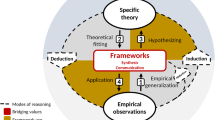Abstract
This paper examines quantitatively the patterns of collaboration over geographical boundaries in the emerging field of sustainability science by empirically analyzing the bibliometric data of scientific articles. The results indicate that an increasing number of countries are engaged in research on sustainability, with the proportion of articles published through international collaboration rising as well. The number of countries engaged in international collaboration on sustainability research has been increasing, and the diversity of countries engaged in research collaboration beyond national borders is also increasing. The geographical patterns of collaboration on sustainability show that research collaboration tends to be conducted between countries which are geographically located closely, suggesting that communication and information exchange might be limited within the regional clusters. The focused fields of research activities on sustainability are significantly different between countries, as each country has its focused fields of research related to sustainability. The specialization of research activities is also observed in international collaboration. While these patterns of international collaboration within regional clusters focusing on specific fields could be effective in promoting the creation, transmission, and sharing of knowledge on sustainability utilizing the already existing regional networks, they could pose a serious obstacle to collecting, exchanging, and integrating diverse types of knowledge, especially when it is necessary to deal with problems involving large-scale complex interactions with long-term implications, such as climate change. It would be of critical importance to establish inter-regional linkages by devising appropriate institutional arrangements for global research collaboration on sustainability science.








Similar content being viewed by others
References
Ahuja G (2000) Collaboration networks, structural holes, and innovation: a longitudinal study. Adm Sci Q 45:425–455
Baba Y, Yarime M, Shichijo N (2009) Sources of success in advanced materials innovation: the role of core researchers in university-industry collaboration in Japan. International Journal of Innovation Management (in press)
Chikyo T (2006) Trends in materials informatics in research on inorganic materials. Kagaku-Gijutsu Doko Kenkyu (58):20–29
Clark WC, Dickson NM (2003) Sustainability science: the emerging research program. Proc Natl Acad Sci USA 100(14):8059–8061
David PA, Spence M (2003) Towards institutional infrastructures for e-Science: the scope of the challenge. Final report of the OII project on “The institutional infrastructure of e-Science: the scope of the issues”. Oxford Internet Institute, 15 September 2003
Emmott S (ed) (2006) Towards 2020 science. Microsoft Corporation
Foray D (2004) The economics of knowledge. MIT Press, Cambridge
Freeman C (1991) Networks of innovators: a synthesis of research issues. Res Policy 20:499–514
Fruchterman TMJ, Reingold EM (1991) Graph drawing by force-directed placement. Softw Pract Exp 21:1129–1164
Haberli R, Klein JT (2001) Summary. In: Klein JT, Grossenbacher-Mansuy W, Haberli R, Bill Alain, Scholz RW, Welti M (eds) Transdisciplinarity: joint problem solving among science, technology, and society: an effective way for managing complexity. Birkhäuser Verlag, Basel
Kajikawa Y, Ohno J, Takeda Y, Matsushima K, Komiyama H (2007) Creating an academic landscape of sustainability science: an analysis of the citation network. Sustain Sci 2:221–231
Kasemir B, Jäger J, Jaeger CC, Gardner MT (eds) (2003) Public participation in sustainability science: a handbook. Cambridge University Press, Cambridge
Kates RW, Clark WC, Corell R, Hall JM, Jaeger CC, Lowe I, McCarthy JJ, Schellnhuber HJ, Bolin B, Dickson NM, Faucheux S, Gallopin GC, Grübler A, Huntley B, Jäger J, Jodha NS, Kasperson RE, Mabogunje A, Matson P, Mooney H, Moore B 3rd, O’Riordan T, Svedlin U (2001) Environment and development. Sustainability science. Science 292(5517):641–642
Komiyama H, Takeuchi K (2006) Sustainability science: building a new discipline. Sustain Sci 1(1):1–6
Matsuda H, Date S, Shimojo S, Wakatsuki K, Furudate T, Kawamura G, Kido Y (2006) Data integration of life science databases using grid technology. Presentation at the German–Japan e-Science Workshop, Tokyo, Japan, 25–26 May 2006
Maurer SM (2006) Inside the anticommons: academic scientists’ struggle to build a commercially self-supporting human mutations database, 1999–2001. Res Policy 35:839–853
National Science Foundation (2003) Revolutionizing science and engineering through cyberinfrastructure. Report of the National Science Foundation Blue-Ribbon Advisory Panel on Cyberinfrastructure. January 2003
Pahl-Wostl C, Mostert E, Tàbara D (2008) The growing importance of social learning in water resources management and sustainability science. Ecol Soc 13(1):24
Powell WW, Grodal S (2005) Networks of innovators. In: Jan F, Mowery DC, Nelson RR (eds) The Oxford handbook of innovation. Oxford University Press, Oxford
Shrum W, Genuth J, Chompalov I (eds) (2007) Structures of scientific collaboration. MIT Press, Cambridge
Stuart TE (1998) Network positions and propensities to collaborate: an investigation of strategic alliance formation in a high-technology industry. Adm Sci Q 43:668–698
Tàbara D, Pahl-Wostl C (2007) Sustainability learning in natural resource use and management. Ecol Soc 12(2):3
Uzzi B (1997) Social structure and competition in interfirm networks: the paradox of embeddedness. Adm Sci Q 42:35–67
Yarime M (2009a) Public coordination for escaping from technological lock-in: its possibilities and limits in replacing diesel vehicles with compressed natural gas vehicles in tokyo. J Clean Prod 17(14):1281–1288
Yarime M (2009b) Eco-innovation through university-industry collaboration: co-evolution of technology and institution for the development of lead-free solders. DRUID Society Summer Conference, Copenhagen, 17–19 June 2009
Acknowledgments
We are very grateful to the anonymous referees for their insightful comments and suggestions, which improved greatly our manuscript. This work was supported by the Ministry of Education, Culture, Sports, Science, and Technology (MEXT) of Japan through Special Coordination Funds for Promoting Science and Technology (Project name: IR3S) and Showa Shell Sekiyu K.K., as a part of the research project “Knowledge Structurization for Sustainability Science” undertaken by the University of Tokyo.
Author information
Authors and Affiliations
Corresponding author
Rights and permissions
About this article
Cite this article
Yarime, M., Takeda, Y. & Kajikawa, Y. Towards institutional analysis of sustainability science: a quantitative examination of the patterns of research collaboration. Sustain Sci 5, 115–125 (2010). https://doi.org/10.1007/s11625-009-0090-4
Received:
Accepted:
Published:
Issue Date:
DOI: https://doi.org/10.1007/s11625-009-0090-4




